FULL AUTOMATION(Intelligent Mobility)
for electric vehicles Design technology of high reliability and
high energy density power components
for mobilities Vehicle panel integrated solar module and
all-in-one electric vehicle system technology Lithium-ion battery technology
for long driving range
and extreme fast charging High-safety, high-capacity sulfide-based
all-solid-state battery technology
for electric vehicles High-efficiency, weight lightening design and
thermal management technology
for electric motors Autonomous and unmanned wireless power
transmission technology
- EV Electric system
- Electronic components and systems installed in electric vehicles, such as power train (drive motor, battery, reducer, etc.), air conditioner (cooling pump, heating device, thermal management device, etc.), sensor (Radar, LiDAR, camera, etc.), vehicle controller (ECU) , including actuators, etc.
- Technical overview
-
It is an electric motor and drive system that can be used for electric vehicles, and it is a core technology for designing and commercializing electric motors that can realize high efficiency, low price, and high performance. By applying a low-cost permanent magnet (Ferrite), compared to the existing expensive rare-earth permanent magnet applied motor
① 55% reduction in material cost ② Realization of high power density of 85% or more ③ Minimize leakage flux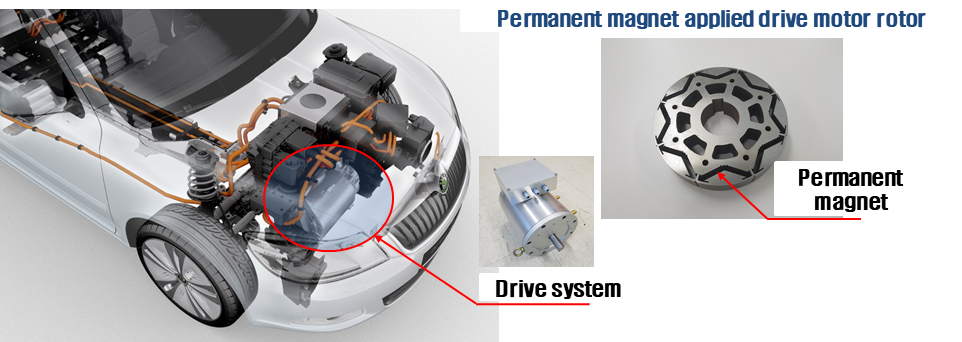
- Necessity and importance
-
(market) The cumulative output of the electric motor market for automobiles reached 3 billion units in 2018, and the electric vehicle motor market is expected to reach USD 5.38 billion in ‘24 (source: Yano Economic Research Institute) In Korea, the average annual delivery volume of 3.37 billion cases (‘20), Delivery food market size: KRW 17.4 trillion (Source: Korea Integrated Logistics Association, Statistics Korea)
(Policy) Future car expansion and market preoccupation strategy ('20), 4th eco-friendly vehicle master plan ('21), Electric drive system technology development required according to electric vehicle expansion policy
- Applications
-
< High-density drive motor applications for electric vehicles >
Areas Description Transport Electric ships, electric railways, drones, etc(eco-friendly transport machines)
Mobility Various electric drive modules and power systems
Electric module for high performance
- Technical overview
-
Technologies including core power component systems required for the electrification of transports such as vehicle, ship, train, drone, etc. and overall systems associated with power component systems such as charging infrastructure, charging service, charging monitoring system, etc. Design technology for high reliability and high energy density power components, high frequency driving technology for next generation semiconductor devices (SiC, GaN), lightweight design technology for magnetic devices (Inductor, Transformer), etc.
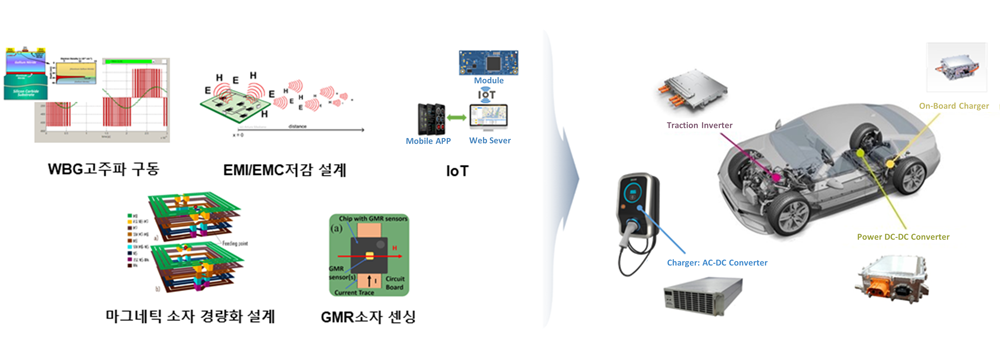
- Necessity and importance
-
(Market) The global personal mobility devices market size is expected to reach USD 18.2 billion by 2028, according to a new report by Grand View Research, Inc. These technologies can be used in a wide variety of applications and have lots of influence, because the demand for high reliability and high energy density lightening of core power components has recently increased.
(Policy) Development support for core components of future cars such as strategy to respond to short-term supply and demand and strengthen industrial capabilities of semiconductor for vehicles(2021), R&D promotion plan of Korean governmental departments for strengthening future car competitiveness(2021), etc.
- Applications
-
< Application area of design technology for high reliability
and high energy density power components >Areas Description Transport Motor driving and convenient electrics systems
Monitoring and remote service platforms
Ships, trains, flying cars, drones, etc.
Infrastructure
and energyHigh efficiency and high reliability power conversion systems
Energy harvesting and management systems
EV fast charging systems, fuel cell system, zero energy buildings, photovoltaic systems, wind electric systems, etc.
- Technical overview
-
Vehicle panel-integrated solar modules and systems that are not limited by vehicle type and powertrain of the armature High power (220W/㎡) vehicle panel integrated solar module Curved and lightweight solar module that can respond to electric vehicle panel curvature Securing the driving range of 80km/day for electric vehicles using pure solar energy
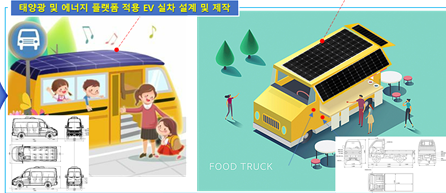
- Necessity and importance
-
(Market) The global electric vehicle market is expected to grow at a CAGR of 26.2% from 3.5 million units in '21 to 28.5 million units in 2030(Source : Joint ministries) The domestic electric vehicle supply scale (cumulative) is expected to be 1.13 million units in '25 and 3 million units in '30 according to the eco-friendly vehicle expansion policy goal
(Policy) Expand green mobility including the Korean version of the Green New Deal (2020) and the 4th Green Car Master Plan (2021)
- Applications
-
< Vehicle panel solar module and All-in-one electric car application >
Areas Description Renewable Energy Convergence of solar/EV technology and energy platform service IT/SW technology
Effect of expanding social venture start-up opportunities in the field of new and renewable energy
When 100,000 200W class vehicle solar modules are installed, 60MWh/day electricity production (3 hours/day charging assumption, 200W class, 100,000 units installed)
electric vehicle system Creation of a new market in the solar power market in power generation business by developing solar cell modules for vehicles, controller systems, and energy electronic systems
- Technical overview
-
Development of 6-minute extreme fast charging >200Wh/kg lithium-ion batteries and the materials
Development silicon-based anode materials and the electrode for >300Wh/kg high energy density lithium-ion batteries
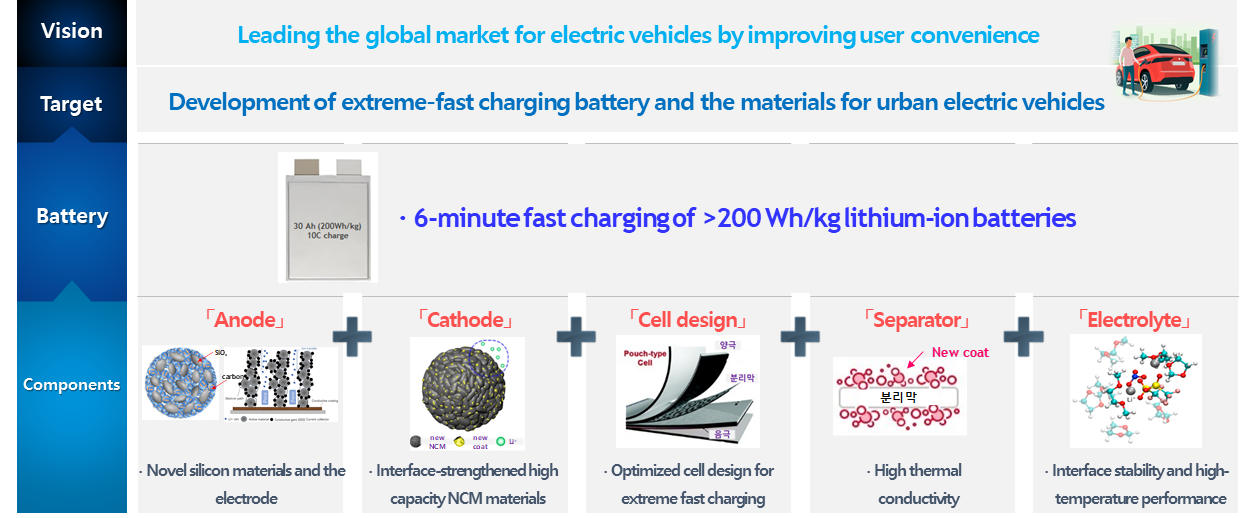
- Necessity and importance
-
(Market) Expected to grow at a CAGR of 25.9% from $30 billion in 2020yr to $150 billion in 2030 for EV battery market (from SNE research)
(Policy) Intensive development of EV battery industry, including cross-ministerial R&D plans to secure future EV competitiveness ('21), and 2030 secondary battery industry development strategy ('21)
- Application
-
< Lithium-ion battery application >
Areas Description EV Power source for EV capable of long driving range(>500km) and 6-minute fast charging
others Large-scale electrochemical energy storage system(ESS), Advanced ICT power sources
- Technical overview
-
Solid electrolyte composition with high ionic conductivity of 10 mS/cm class with atmospheric stability and Low-cost mass-production manufacturing technology Anode material technology specialized for all-solid-state batteries, electrode manufacturing technology for anode electrode thick film, anodeless negative electrode manufacturing technology, stacked all-solid-state battery manufacturing technology, etc.
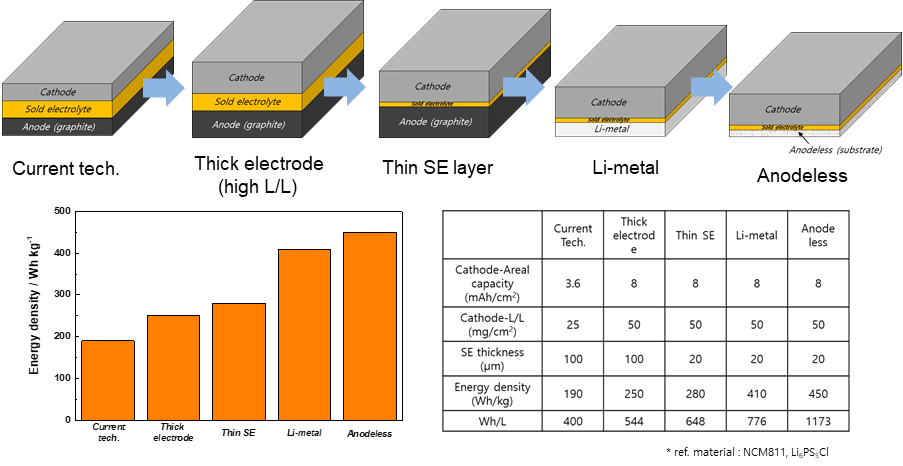
- Necessity and importance
-
(Market) All-solid-state batteries are expected to grow at an average annual rate of 66% by 2030, accounting for 10% of the electric vehicle market by 2030, and the market share is expected to increase rapidly when the cost is lowered(Source : SNE research)
(Policy) All-solid-state battery technology, such as cross-ministerial R&D promotion plan to secure competitiveness in future cars ('21), future R&D promotion plan for materials, parts, and equipment ('21), and 2030 secondary battery industry development strategy ('21) Intensive development support
- Application
-
< All-solid-state battery technology applications >
Areas Description transportation Electric vehicles, unmanned aerial vehicles and drones operating in low and high temperature environments
IT mobile devices
military Power for field military equipment
- Technical overview
-
High-efficiency, weight lightening motor design technology such as ‘Synchronous Reluctance’, which reduced manufacturing cost by 15% using the existing induction motor stator and ‘Ferrite Magnet Used Motor’, which reduced weight by 40% using low-cost permanent magnets and heat dissipation structure optimization technology for effective thermal management.
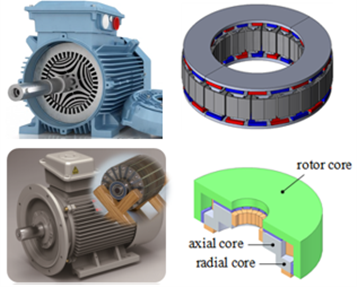
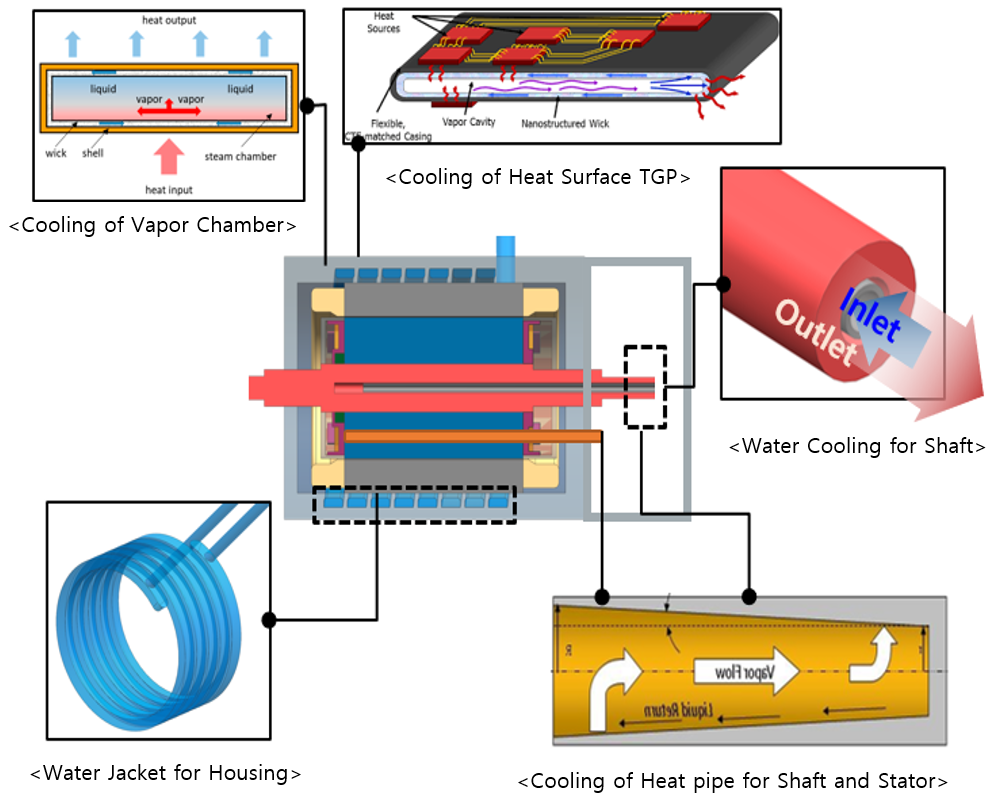
- Necessity and importance
-
(Market) The global motor market is worth 150 billion dollars, and if it develops an IE4 class motor and take up a 1% market share, an economical effect of about 1.5 billion dollars is expected. The global thermal management market is expected to grow at a CAGR of 7.7% from $11.1 billion in 2019 to $14.2 billion in 2025 (Source : Markets and Markets)
(Policy) It conforms to the national greenhouse gas reduction plan and energy consumption reduction policy, and can contribute to global carbon/fine dust emission reduction
- Application
-
< lightweight/high-efficiency motor design technology & Thermal Management Technology >
Areas Description Industrial/ robot automation Industrial motor
Electric motor for robot automation
energy Renewable energy/electric power generation motor
transportation Electric drive for traction for EV, Train
Drone/Airline Electric Propulsion System
- Technical overview
-
AI-based intelligent wireless power transmission/reception system that enables e-mobility (personal mobility, electric vehicle, etc.) and autonomous driving service robots to wirelessly charge themselves
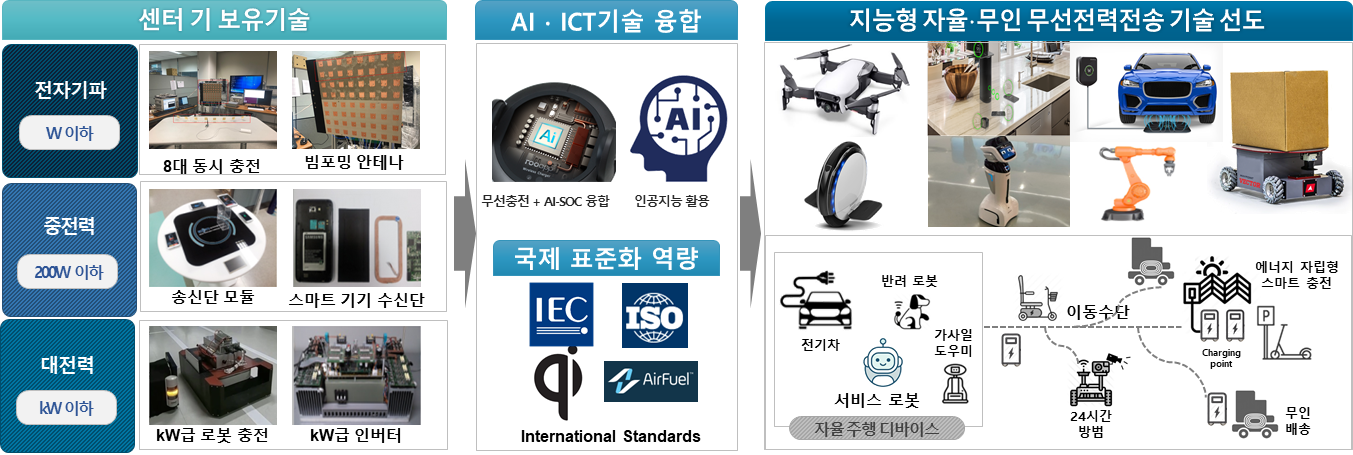
- Necessity and importance
-
(Market) The global wireless power transmission market is expected to grow at a CAGR of 17.5% from $1.13 billion in 2019 to $3.79 billion in '24(Source : Omdia)
(Policy) The government has been supporting about 40 cases of wireless charging R&D for the past 10 years (2011-21), and is currently investing in R&D to support the localization of related core parts and infrastructure convergence.
- Application
-
< Wireless power transmission application >
Areas Description low power Mobile cell phone, wearable device, IoT devices, healthcare device
middle power Laptop/drone/small home appliance/household robot (cleaning, housekeeping support, companion, security, delivery, etc.), LED lighting, etc.
High power Electric vehicles, industrial robots, industrial equipment, agricultural service robots, AGVs, etc.
Copyright(C) 2016 KOREA ELECTRONICS TECHNOLOGY INSTITUTE., All Rights Reserved.


